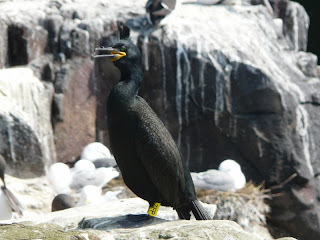 |
| A warm welcome! Britain's smallest bird, the Goldcrest. |
Wednesday 17th April comments: Bird ringing has been used a tool for learning about the mysteries and wonders of migration for years. It has evolved from primitive forms such as coloured paper and metal rings to more intricate and brilliant technology such as GPS loggers and satellite transmitters.
On the Farnes, we study both the migrant birds that pass
through the islands and the breeding birds that can be here for as little as
three months. Both of these groups of birds can travel huge distances to be
here, with Arctic Terns spending the winter in Antarctic waters and Wheatears
taking on monster sub-Saharan migrations to and from their breeding grounds.
The work we do out here is extremely interesting and has thrown up some great
surprises over the years.
 |
| Arctic Tern ringed ready to get on the wing! |
For example, take our Puffins! Some birds ringed on the
Farnes have lived to be over thirty years old, we have learned that some birds
return to the same burrows every year and that some pairs can mate for life! Our
colour ringing studies on Shags have unraveled some patterns of migration
previously unknown to us. A lot of Farnes Shags spend the winter up in
north-east Scotland and with many of these birds being affected in the recent
seabird wrecks, our studies have never been more important.
 |
| Shag 'ZFP' originally ringed on the Isle of May now breeding on the Farnes. |
Our intensive studies on Arctic Terns have revealed that
birds often return to within a few feet of their nest site every year and our
oldest birds (again over thirty!) will have totted up over a million miles
simply migrating to the Farnes every year from their wintering grounds.
Amazing!
Ringing migrant birds can be a great way to track their
migrations across the country and all around Europe. A startling discovery last
year came in the form of a young female Blackbird caught in one of the
buildings sporting a very special piece of jewellery…. A Norwegian metal ring! We know that the thrushes passing through the
islands in the autumn are coming from Scandanavia but it was great to get this
kind of ‘in the hand’ proof.
 |
| A Scandanavian surprise! |
 |
| One hell of a journey, our nomadic Blackbirds' map. |
When a bird gets a ring, it’s like giving it an individual
passport. It carries a unique code which identifies it as an individual and
enables us to build up life histories for birds. It weighs a very small percentage of a birds bodyweight and is the equivalent of us wearing a watch or a ring. It can tell us how long birds
live for, give us an insight into population dynamics, explain changes in
habitat and climate and ultimately help us to understand birds in more detail.
 |
| Brambling passing through on the way to Scandanavia. |
Throughout the year we will be holding ringing demonstrations to try and show people the science behind bird ringing and get people up close and personal with birds. So fingers crossed, next time you pay a visit we might be able to share with you the rare treat of a bird in the hand!

No comments:
Post a Comment